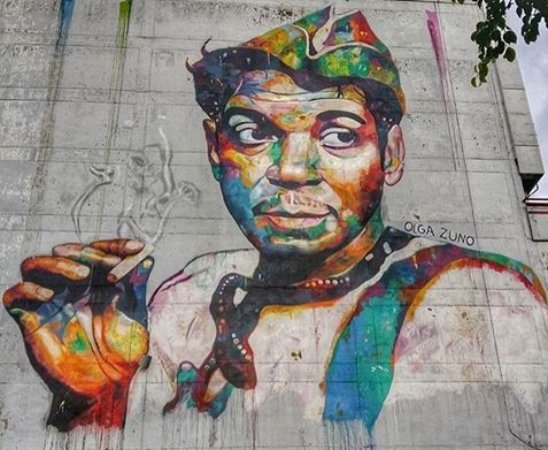Gamboling with my ferocious (pun intended, he’s a walking stuffed toy) dog, Jasper, on Aurora today I noticed the parking lot was for sale that features my favorite historical mural. Before it disappears I wanted to explain how what appears to be a typical San Miguel parade is really a Reader’s Digest version of local history.
Naturally the parade starts at the Parroquia, named for the town’s namesake, St. Michael on whose feast day the Battle of Barbarians ended in 1530 gaining the area our moniker, San Miguel.
Beneath the church is a profile of man, typical indigenous art of the Pre-Hispanic era. The lad is being devoured by a dragon. Specifically St. Martha’s dragon, a world-wide legend that came over with the Spanish, of how St. Martha represented the Church destroying all previous and pagan religious beliefs.
Alongside St. Martha’s dragon come two two elders, father and mother, representing the ancient gods Cipactonal and Oxomoco who taught mankind complex rites. Think of them as a kind-of indigenous version of the Western Adam and Eve story. From her, we have the name of our local 7-11’s, Oxxo.
Alongside the couple is Pancho Villa, one of the most prominent figures of the Mexican Revolution often portrayed as a Mexican version of Robin Hood, stealing from the rich to give to the poor.
Next to him is a Lucha Libre, or professional wrestler, with his trademark mask and tight pants recently named by Mexico as part of the intangible cultural history of the country.
Front and center are the Otomi-made rag dolls named for Mary and St. Joseph. The dolls have been made by the indigenous long before the Conquistadors arrived and their popularity has hit a recent zenith. A hot air balloon shaped like a Maria doll has traveled the globe to be photographed at Big Ben, the Sydney Opera House, the pyramids and alike bringing good will to our local folk art and the country as a whole.
Next comes the lottery game folks for the drunk and the lady. The lottery originated in Italy in the 15th century and was brought to New Spain (Mexico) in 1769. In the beginning, the lottery was a hobby of the upper classes, but eventually it became a tradition at Mexican fairs and throughout the classes. Playing lottery is similar to bingo, though more visually and intellectually engaging featuring announcer calls with innuendos to sex or politics.
The drunk and the lady walk with the devil, an ever present figure in Guanajuato, even in nativities to show how his reign on earth has ended with Jesus’ arrival. Personally, I like the devil in crèches as he tends to add a bit of folly and musicality to the event as he is often featured playing an instrument.
Behind them are mojigangas, the grotesque, giant, papier-mâché puppets originally portraying saints to help with indigenous conversions. Their long arms and hands cleared the street of any evil before the religious art was presented. Later they became parodies of the wealthy Spanish in San Miguel. Today they are often featured at weddings leading the wedding party from the mass to the reception, again clearing the street of any evil.
Some mojigangas are a catrina (skeleton person) as is the mariachi band. Catrinas were originally a political cartoon making fun of the wealthy reminding them we are all the same under the fancy duds. Over the next century Catrinas evolved into a folk-art form and worldwide icon for Days of the Dead.
In the background are crepe paper stars in honor of Mary of the Light, the patron of electricians. Back in the 1920s recently unemployed electricians came to town from Salvatierra to work at the factory bringing the star custom with them. Suffice to say, stars for Mary found their new home enticing and are featured in most every procession.
Also featured are Alebriges, the colorful and carved wooden folk art available at every craft fair and in the Artist’s Market. Originating in Oaxaca, the wood figures are normally cats, dogs, deer, raccoons, leopards, etc., that have been elaborated into fantastic figures. They started in an artist’s nightmare when he awoke screaming the word “Alebriges” and started carving a folk art niche.
Bringing up the rear is a bull, a nod to when bulls roamed the streets yearly to promote bull fights causing much mayhem. This tradition was before the days of animal rights.
By the bull is President Trump and Cantinisflas. Cantinisflas is considered Mexico’s version of Charlie Chaplin’s tramp – the cinematic clownish underdog audiences adored. In English, his big Hollywood movie was Around the World in 80 Days. He owned various properties overlooking town and is much beloved.
So sashay on down Aurora to enjoy a mural before it goes away. Or enjoy San Miguel’s oldest and most popular mural tour, or any of my historical tours, as public art is always featured. Our long tradition of murals helps make a casual errand trip both aesthetic pleasing and historically relevant!
by Joseph Toone
Joseph Toone is the Historical Society’s short-story award winning author of the SMA Secrets book series. All books in the series are Amazon bestsellers in Mexican Travel and Holidays. Toone is SMA’s expert and TripAdvisor’s top ranked historical tour guide telling the stories behind what we do in today’s SMA. Visit HistoryAndCultureWalkingTours.com, and JosephTooneTours.com.











